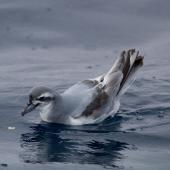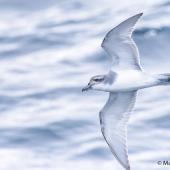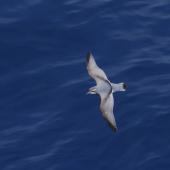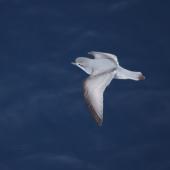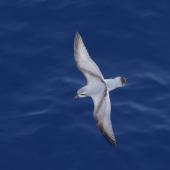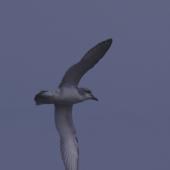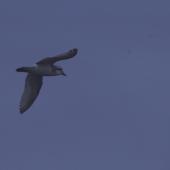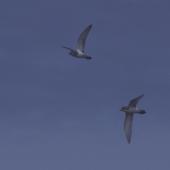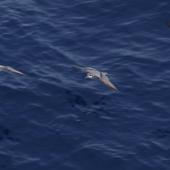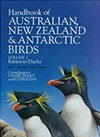Salvin's prion
Pachyptila salvini (Mathews, 1912)
Order: Procellariiformes
Family: Procellariidae
Other names: lesser broad-billed prion, medium-billed prion, Crozet Island prion, Salvins prion
Geographical variation: The rare and little-known MacGillivray’s prion (macgillivrayi) from St Paul Island in the southern Indian Ocean may be a subspecies of Salvin’s prion, or of broad-billed prion, or a full species.
Salvin’s prion is an abundant small seabird of the southern Indian Ocean, breeding in vast colonies on the Crozet and Prince Edward Islands. They are very similar in appearance to the five other prion species: blue-grey and black above, and white below, with blue-grey bill and blue legs. Salvin’s prions do not breed in the New Zealand region, but are often found storm-wrecked on beaches in late winter, especially on the west coast of the North Island.
Identification
All six prion species are very similar in appearance and behaviour, differing mainly in bill shape. All are medium-small seabirds that are blue-grey above and white below, with a blackish ‘M’ across the back from wingtip to wingtip, a black tip to the upper tail, blue-grey bill, and blue legs and feet.
Voice: prions rarely call at sea, but they are vocal on the ground at night at their breeding colonies, giving harsh chattering calls and softer dove-like crooning.
Similar species: Salvin’s prion is most similar in bill structure to the Antarctic prion, and the two also have very similar facial markings. The main characters used to distinguish them in the hand are that Salvin’s prion generally has a slightly larger, darker bill (13.5-17.5 mm wide) with a smaller nail at the tip, outwardly-bowed sides to the bill when viewed from above, and lamellae (comb-like filters) that are visible from the side when the bill is closed. In contrast, the Antarctic prion has a slightly smaller (11-15.5 mm wide), bluer bill with relatively larger nail, straight sides to the bill when viewed from above, and the lamellae are not visible when the bill is closed. The broad-billed prion has a more massive bill (18.7-24.3 mm wide) that is darker than that of other prions (lead-grey, shading to blue at the widest margins, and with a blue lower mandible).
Distribution and habitat
Salvin’s prions breed in vast colonies on Prince Edward and Marion Islands and especially the Crozet Islands in the southern Indian Ocean. They nest in short (0.9-1.5 m long) burrows under tussock. At sea, Salvin’s prions mainly occur close the Antarctic Convergence, near their breeding islands. In winter their range extends west to South Africa and east to New Zealand, where they often wash ashore on the west coast of the North Island, and occasionally on Chatham Island. Large numbers of birds are cast ashore in June-July some years, e.g. 1307 in 1970, 5228 in 1974, and many thousands in 2012.
There are few claimed sightings of Salvin’s prions off the New Zealand mainland, but this is partly due to the extreme difficulty of separating prion species at sea.
Population
World population c. 5.4 million pairs. The main population is on the Crozet Islands, principally on Ile aux Cochons and Ile de l’Est, but also Ile de la Possession, Ile des Apôtres, and Ile des Pengouins; up to 100,000 pairs breed on Prince Edward and Marion Islands.
Threats and conservation
Most breeding islands are now free of introduced predators, but feral cats are present on Ile aux Cochons, and ship rats limit breeding success on Ile de la Possession (both in the Crozet Islands). Feral cats (since eradicated) killed many thousands of Salvin’s prion on Marion Island between 1949 and 1991.
Breeding
Salvin’s prions breed in large colonies, returning in late September and laying the single white egg (50 x 36 mm) in late November or early December. They breed as monogamous pairs, sharing incubation (44-55 days) and chick-rearing (54-65 days), with the young departing in late March and early April.
Behaviour and ecology
Salvin’s prions occur in large flocks near their breeding islands, often mixed with other prion species. They are generally not attracted to boats, but will fly alongside large vessels. They visit breeding sites after dark and depart before dawn, or stay in burrows or nest crevices during daylight. Large numbers are killed by subantarctic skuas. Many birds disperse eastward outside the breeding season, and are often found storm-wrecked on the south coast of Australia and the west coast of New Zealand.
Food
Salvin’s prions mainly eat small pelagic crustaceans, along with small fish and squid. Food items are mainly captured by shallow dives or surface-seizing while hydroplaning – facing into the wind with wings extended, and dipping the head and neck into the upper 10 cm of the water column.
Websites
References
Marchant, S.; Higgins, P.J. (eds.), 1990. Handbook of Australian, New Zealand and Antarctic birds. Vol 1, ratites to ducks. Oxford University Press, Melbourne.
Miskelly, C.M.; Bester, A.J.; Bell, M. 2006. Additions to the Chatham Islands’ bird list, with further records of vagrant and colonising bird species. Notornis 53: 215-230.
Onley, D.; Scofield, P. 2007. Field guide to the albatrosses, petrels and shearwaters of the world. Christopher Helm and A&C Black Publishers Ltd, London.
Powlesland, R.G. 1989. Seabirds found dead on New Zealand beaches in 1986 and a review of Pachyptila recoveries since 1960. Notornis 36: 125-140.
Shirihai, H. 2007. A complete guide to Antarctic wildlife: the birds and marine mammals of the Antarctic continent and the Southern Ocean. 2nd edn. A & C Black, London.
Recommended citation
Miskelly, C.M. 2013. Salvin’s prion. In Miskelly, C.M. (ed.) New Zealand Birds Online. www.nzbirdsonline.org.nz
Salvin's prion
- Breeding season
-
- Jul
- Aug
- Sep
- Oct
- Nov
- Dec
- Jan
- Feb
- Mar
- Apr
- May
- Jun
- Egg laying dates
-
- Jul
- Aug
- Sep
- Oct
- Nov
- Dec
- Jan
- Feb
- Mar
- Apr
- May
- Jun
Salvin's prion
- Breeding season
-
- Jul
- Aug
- Sep
- Oct
- Nov
- Dec
- Jan
- Feb
- Mar
- Apr
- May
- Jun
- Egg laying dates
-
- Jul
- Aug
- Sep
- Oct
- Nov
- Dec
- Jan
- Feb
- Mar
- Apr
- May
- Jun






